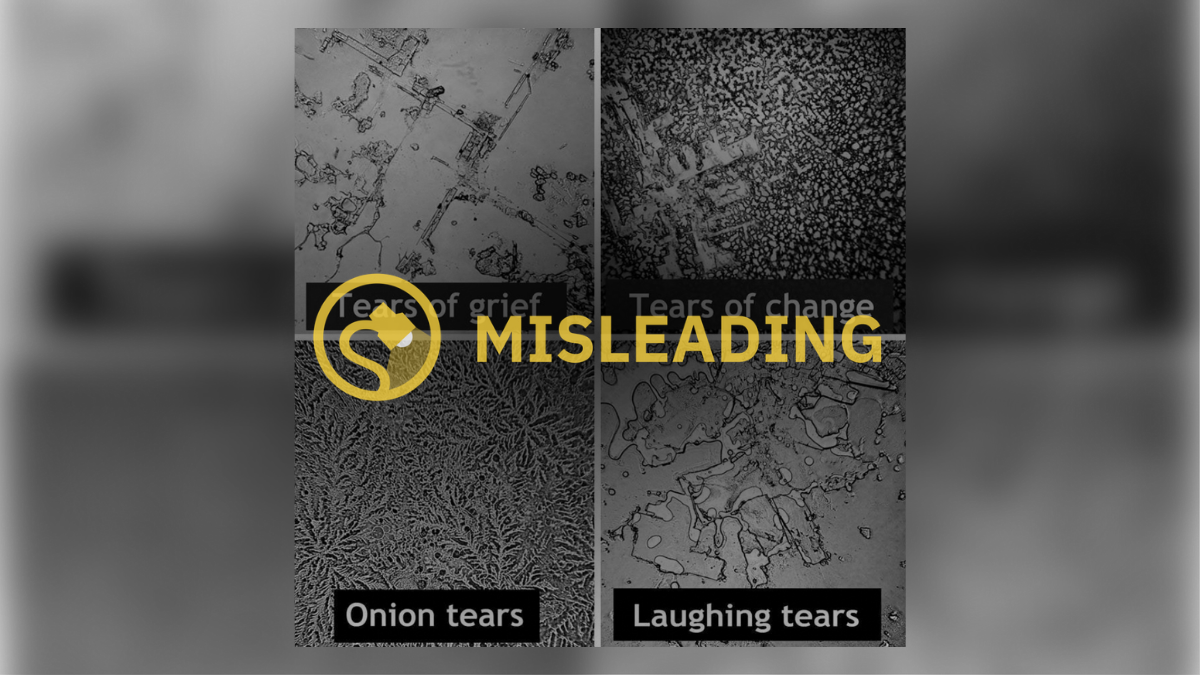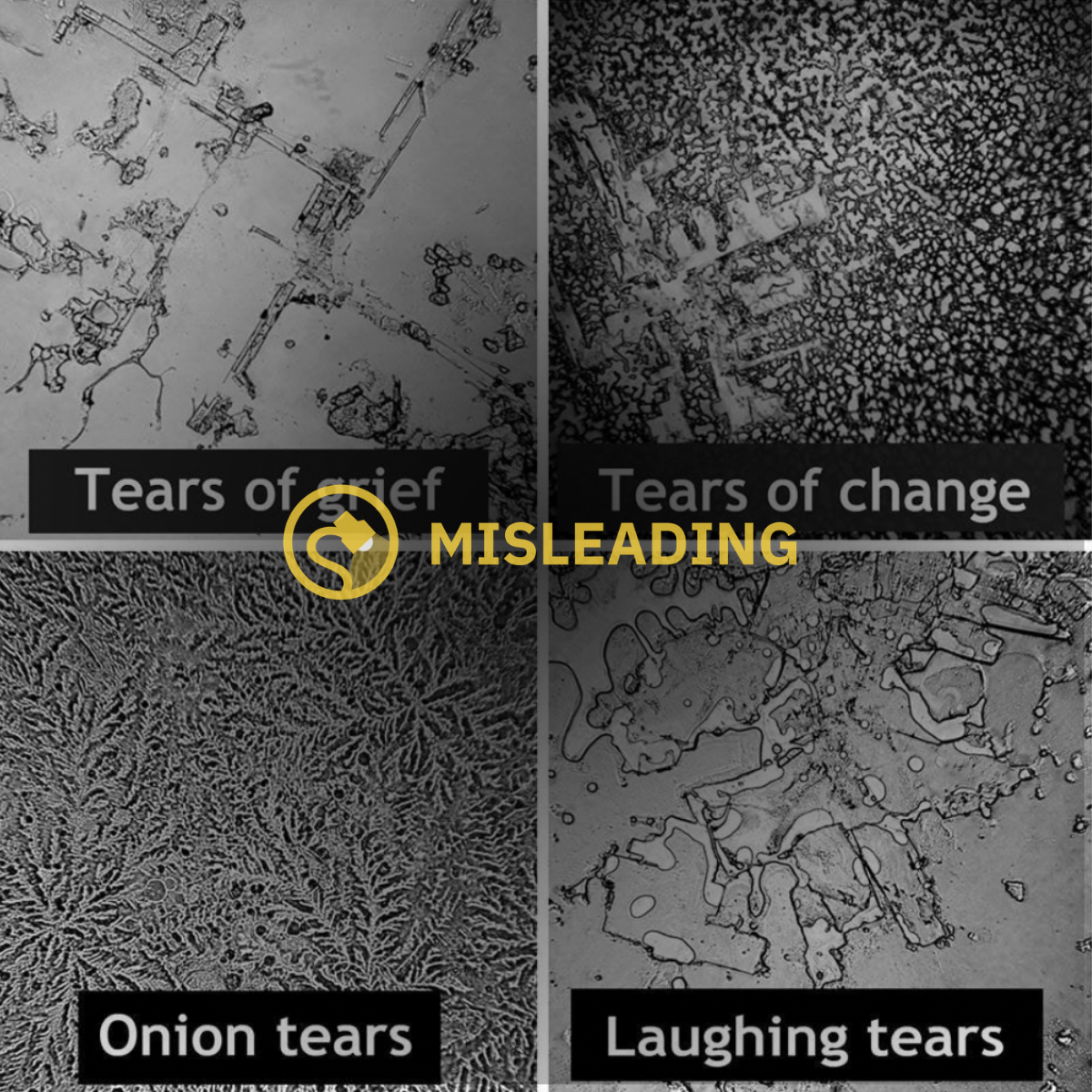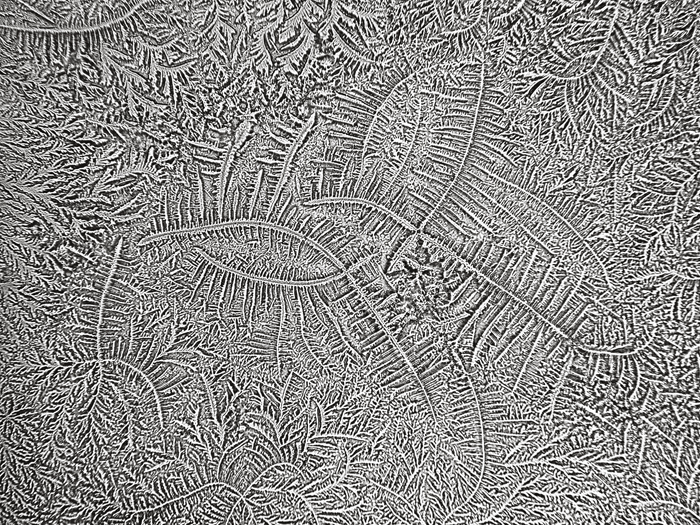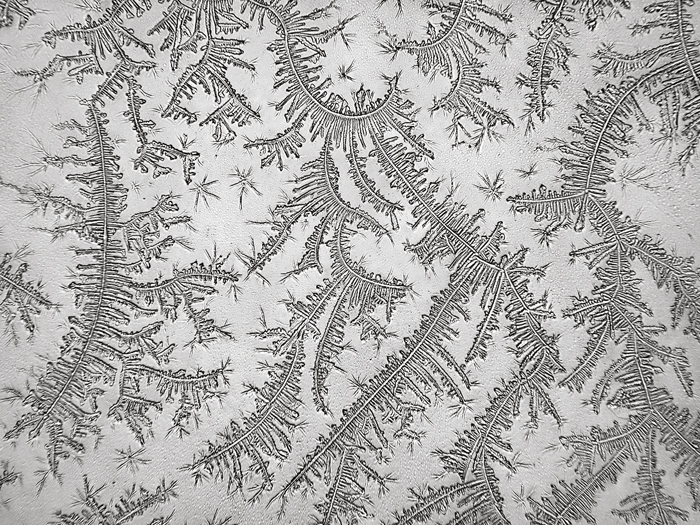The images in a meme are authentic photographs of tears under a special type of microscope. It is also true that there are three types of tears, each of which is produced through a different biological process and contains its own unique makeup.
However, exactly how these tears are differentiated and what they look like under a microscope depends on a variety of factors, a process that is poorly understood by the scientific community. And to say that tears caused by one emotion are "structurally different" than those of another is misleading and inaccurate.
Much like a snowflake, a person’s tears are as unique as the emotions they are evoked by. At least, that’s the case according to one widely shared meme.
Tears flow for a variety of reasons. While it is true that each individual tear is unique, exactly how its chemical composition differs from another is still poorly understood by the scientific community. As such, we have rated this claim as “Mixture.”
Such memes have circulated online since at least 2013 when Smithsonian Magazine covered the tear phenomenon. The question has also been posed on sites like Quora and in various iterations on Reddit, including a recent post from Jan. 13, 2022. One Facebook post, which had amassed more than 148,000 shares, inaccurately stated that tears are "literally made up of different things" and that "happy tears are structurally different than sad tears than angry tears than overwhelmed tears etc. Different types of tears have distinct molecules.”
We found that the meme's photographs of tears were real and were captured by photographer Rose-Lynn Fisher as part of the book, “The Topography of Tears.” Described as a “visual investigation of tears,” Fisher photographed her own tears using an optical standard light microscope that was mounted with a digital microscopy camera.
In an email to Snopes, Fisher said that the first unauthorized use of her work was created in 2014 and has been posted on the internet since.
"It depicts tears of change, grief, laughing, and onion fumes with labels, as though they represent categories of tears. Not only does the graphic misrepresent my work, but some of the text with this meme in part implies that my images are depicting the different chemical and biological makeup of tears as if this was an established, conclusive fact represented by the graphic, and attributed to me," said Fisher.
"The images in the graphic are cropped from my images and put together in a way that I would never have approved because they misrepresent the nature of my own work on this series."
That series started in 2008 during what Fisher described as a period of life changes and grief. She recognizes that the "the empirical nature of tears is a composition of water, proteins, minerals, hormones, antibodies and enzymes," but her work represents "a momentary landscape, transient as the fingerprint of someone in a dream."
She also added that she is a visual artist, not a scientist.
"I approached my 'Topography of Tears' project as a contemplative and visual investigation, as art. I wondered what tears look like, and I wondered if tears of grief would look the same as tears of joy," explained Fisher, who photographed the tears using an optical microscope — not an electron microscope as some memes have claimed — attached to a standard light. Emotion-based tears were collected for over eight years from Fisher's own eyes, as well as some onion tears and tears from other people.
"Every tear that I looked at under the microscope had its own qualities — its own sort of 'signature' — whether it was from the same emotion or different emotions. For example, tears of grief could look different from each other, even when they were shed in the same moment. And similar patterns were sometimes revealed in tears provoked by different emotions. I often thought of these tear images evoking a sense of place, like aerial views of emotional terrain, and I observed with wonder how the organic structures and patterns of nature repeat at every scale," explained Fisher.
Furthermore, Fisher's artistic representation of tears was not scientifically structured or repeatable. Some tears were saved on glass slides and left to evaporate, while other tears were compressed between a glass slide and thin glass cover, causing the tear to spread out and create a different visual effect. Different microscope and camera settings, as well as aesthetic preferences about contrast detail, also influenced the image.
" A scientific study requires repeatability. For example, if I am one person who saved 100 tears, but it would take 100 people to save 100 tears under the same emotional and environmental conditions, using the same methodology in collecting the tear samples in a consistent way to even begin to see what was scientifically valid," said Fisher.
While it is true that different tears are produced in different ways and contain different chemical and biological makeup, the images in this meme are influenced by several variables, according to Fisher. Those include whether the tear was air-dried or compressed, the volume of the fluid, the microscope and camera settings, how the photograph was printed and, of course, chemical, and biological variations.
Tears form for a variety of reasons. They express emotions to those around us, help keep the eye safe and healthy, and wash away irritants that get stuck in our eyes. Dr. Michael Roizen of the nonprofit medical center Cleveland Clinic said that crying for emotional reasons not only releases tensions but can physically deliver nutrients and “wash out stress-related toxins.” Crying also helps us communicate our needs, like distress or sincerity.
Each type of tear — basal, reflexive, or emotional — has its own specially designed role, each of which the Cleveland Eye Clinic say is produced by glands around the eye to maintain eye health.
Basal tears may be shed by a person without them even knowing it. These tears are always present in the eyes and help lubricate, nourish, and protect the transparent part of the eye that covers the iris and pupil known as the cornea. Basal tears keep dirt and other microscopic items out of the eye and act as a “constant shield between the eye and the rest of the world.”
Reflex tears are the body’s response to an external trigger, like slicing onions or getting smoke in the eye. Reflex tears form to wash away such irritants and contain antibodies to protect against bacteria. They are also released in larger amounts than basal tears.
Emotional tears are those that occur when a person experiences sadness, happiness, fear, or other emotions and act as a social cue to those around us. As Fisher stated, the scientific understanding of the visual and chemical differences in emotional tears is limited. Scientists believe there may be additional hormones or proteins present in emotional tears.
Tears are produced in lacrimal glands above each eye, and as a person blinks, tears spread across the eye before draining into small holes in the corner of the eyelids known as puncta. Emotional and reflex tears overwhelm this drainage system, according to the American Academy of Ophthalmology, which is why these types of tears can stream down a person’s face.
Whether it’s to remove a speck of dust or express sincere gratitude to a loved one, tears are innate to the human experience.
Sources
“Shedding tears, shedding old skin. It’s as though each one of our tears carries a microcosm of the collective human experiences, like one drop of an ocean,” described Fisher.
“All About Emotional Tears.” American Academy of Ophthalmology, 28 Feb. 2017, https://www.aao.org/eye-health/tips-prevention/all-about-emotional-tears.
Balphazzar. “The Chemical Makeup/Structure of Tears Changes Depending on Their Origin. Photo Credit: Rose-Lynn Fisher (Source in Comments).” R/BeAmazed, 13 Jan. 2022, www.reddit.com/r/BeAmazed/comments/s2selc/the_chemical_makeupstructure_of_tears_changes/.
coffins. “TIL We Have Three Types of Tears - Basal, Reflex and Psychic. Psychic Tears, the Ones We Produce When We Are Sad, Have a Different Chemical Make up than the Other Two and Contain a Natural Painkiller, Leucine Enkephalin, Which Is Perhaps Why We Feel Better after We Cry.” R/Todayilearned, 7 May 2018, www.reddit.com/r/todayilearned/comments/8hjppy/til_we_have_three_types_of_tears_basal_reflex_and.
“Does the Chemical Composition of Tears Differ Based on the Emotion That Is Causing the Tears?” Quora, https://www.quora.com/Does-the-chemical-composition-of-tears-differ-based-on-the-emotion-that-is-causing-the-tears. Accessed 14 Jan. 2022.
“FACT CHECK: Are No Two Snowflakes Alike?” Snopes.Com, https://www.snopes.com/fact-check/no-two-snowflakes-alike/. Accessed 14 Jan. 2022.
“Facts About Tears.” American Academy of Ophthalmology, 21 Dec. 2016, https://www.aao.org/eye-health/tips-prevention/facts-about-tears".
Magazine, Smithsonian, and Joseph Stromberg. “The Microscopic Structures of Dried Human Tears.” Smithsonian Magazine, https://www.smithsonianmag.com/science-nature/the-microscopic-structures-of-dried-human-tears-180947766/. Accessed 14 Jan. 2022.
“Michael Roizen, MD.” Cleveland Clinic, https://my.clevelandclinic.org/staff/6161-michael-roizen. Accessed 14 Jan. 2022.
Rose-Lynn Fisher / Tears. https://www.rose-lynnfisher.com/tears.html?fbclid=IwAR1GmZLAonZCJ1gp0cyMPxNWiw2Bp-vcP8kiWYFopHEgGoQkVBE8eMmOAbE. Accessed 14 Jan. 2022.
SojourningCPA. “TIL the Three Basic Types of Tears – Basal, Emotional, and Reflex – Have Measurably Different Chemical Compositions.” R/Todayilearned, 20 Oct. 2021, www.reddit.com/r/todayilearned/comments/qc8zdx/til_the_three_basic_types_of_tears_basal/.
Three Types of Tears | What Are Tears Made of? | Cleveland Eye Clinic. 16 July 2019, https://www.clevelandeyeclinic.com/2019/07/16/three-types-of-tears/.
“Why We Cry and What Tears Are Made Of.” Cleveland Clinic, 14 Oct. 2020, https://health.clevelandclinic.org/tears-why-we-cry-and-more-infographic/.




